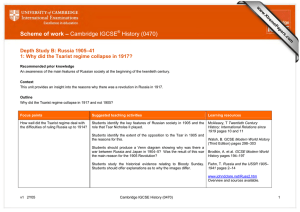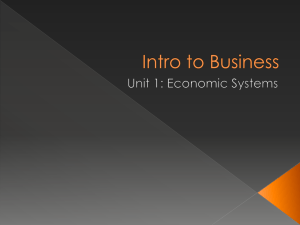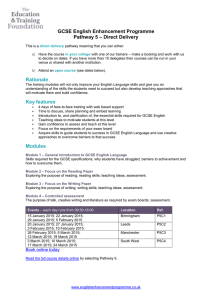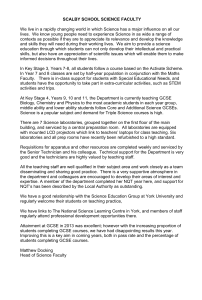Scheme of work – Cambridge IGCSE History (US) 0416
advertisement
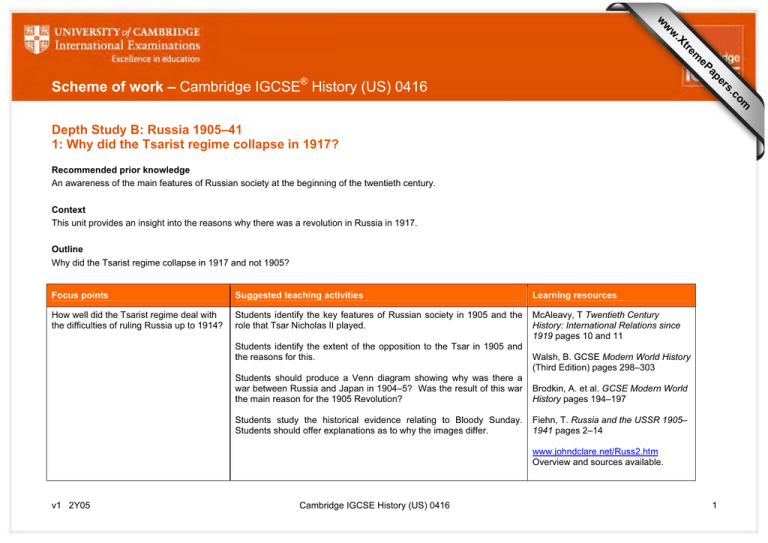
s er ap eP m e tr .X w w w om .c Scheme of work – Cambridge IGCSE® History (US) 0416 Depth Study B: Russia 1905–41 1: Why did the Tsarist regime collapse in 1917? Recommended prior knowledge An awareness of the main features of Russian society at the beginning of the twentieth century. Context This unit provides an insight into the reasons why there was a revolution in Russia in 1917. Outline Why did the Tsarist regime collapse in 1917 and not 1905? Focus points Suggested teaching activities Learning resources How well did the Tsarist regime deal with the difficulties of ruling Russia up to 1914? Students identify the key features of Russian society in 1905 and the role that Tsar Nicholas II played. McAleavy, T Twentieth Century History: International Relations since 1919 pages 10 and 11 Students identify the extent of the opposition to the Tsar in 1905 and the reasons for this. Walsh, B. GCSE Modern World History (Third Edition) pages 298–303 Students should produce a Venn diagram showing why was there a war between Russia and Japan in 1904–5? Was the result of this war the main reason for the 1905 Revolution? Brodkin, A. et al. GCSE Modern World History pages 194–197 Students study the historical evidence relating to Bloody Sunday. Students should offer explanations as to why the images differ. Fiehn, T. Russia and the USSR 1905– 1941 pages 2–14 www.johndclare.net/Russ2.htm Overview and sources available. v1 2Y05 Cambridge IGCSE History (US) 0416 1 Focus points Suggested teaching activities Learning resources http://kenbaker.wordpress.com www.ibiblio.org www.google.co.uk Collection of images of Bloody Sunday How did the Tsar survive the 1905 revolution? Students study the Russian cartoon entitled ‘The Russian Tsars at Home’ before considering ‘How well does this cartoon reflect the influence of Rasputin on the Tsar and Tsarina?’ Students consider in groups –‘The October Manifesto was worthless’ and ‘Was the appointment of Stolypin successful?’ Walsh, B. GCSE Modern World History (Third Edition) pages 304–305 Brodkin, A. et al. GCSE Modern World History pages 198–202 Fiehn, T. Russia and the USSR 1905– 1941 pages 15–23 www.bbc.co.uk/schools/gcsebitesize/hi story/mwh/russia/ Overview and test. www.youtube.com/watch?v=GlER4CyI ir8 YouTube lecture clip with slides. http://wewanttoknowmore.blogspot.co. uk How far was the Tsar weakened by the First World War? v1 2Y05 From a collection of Russian cartoons of the time, students decide (a) are the messages similar and (b) if the reasons for publication similar. http://ows.edb.utexas.edu/site/kmb227 7edc370s/editorial–cartoons Political cartoons from the period. Students identify the problems facing the Tsar and the Russian people during the First World War and record these on pieces of card. A sorting exercise will place them in order of relative importance. In groups discuss the reasons for the order selected. Walsh, B. GCSE Modern World History (Third Edition) pages 306–309 Students investigate the relationship between Rasputin and the royal family and the extent to which this was a major factor in the Tsar’s Fiehn, T. Russia and the USSR 1905– 1941 pages 27–29 (Rasputin focus) Cambridge IGCSE History (US) 0416 Brodkin, A. et al. GCSE Modern World History pages 203–204 2 Focus points Suggested teaching activities Learning resources weakening position during the First World War. www.bbc.co.uk/schools/gcsebitesize/hi story/mwh/russia/ Overview and test. Why was the revolution of March 1917 successful? Students will identify the factors that led to the 1917 (March) revolution. The factors should be presented in a diagrammatical format. The factors should be ranked in order of importance with reasons being given for the choices made. A comparison of the 1905 and 1917 revolutions is discussed in an attempt to identify why in 1917 the Tsar decided to abdicate. McAleavy, TTwentieth Century History: International Relations since 1919 Pages 10 and 11 Walsh, B. GCSE Modern World History (Third Edition) pages 309–313 Brodkin, A. et al. GCSE Modern World History pages 205–206 Fiehn, T. Russia and the USSR 1905– 1941 pages 30–36 www.johndclare.net/Russ3.htm Sources on March Revolution 1917. www.youtube.com/watch?v=GQUAW_ CdBds&feature=related YouTube four-part series on WWI and March Revolution. Students revise the work completed at the end of this section and complete a past Cambridge IGCSE question paper on this topic. v1 2Y05 Cambridge IGCSE History (US) 0416 Past questions papers – can be accessed by logging onto the Cambridge Teacher Support website http://teachers.cie.org.uk 3 Depth Study B: Russia 1905–41 2: How did the Bolsheviks gain power, and how did they consolidate their rule? Recommended prior knowledge A background knowledge of Russia in 1917, those in power and those striving for power. Context This unit provides an insight into how the Bolsheviks were able to gain and hold on to power. Outline Why did the Provisional Governments fail and how did the Bolsheviks gain power? Focus points Suggested teaching activities Learning resources How effectively did the Provisional Government rule Russia in 1917? Students examine the problems facing the Provisional Government in1917 and present these in the form of a Venn diagram. Walsh, B. GCSE Modern World History (Third Edition) pages 311–313 The teacher identifies with the class the reasons for the steady decline of the Provisional Government’s authority. Brodkin, A. et al. GCSE Modern World History pages 207–210 The problems from the two exercises above can be set out down the left side of a table. Students then research and identify government action in relation to each. A final column should comment as to how effective the Provisional Government action was. Fiehn, T. Russia and the USSR 1905– 1941 pages 38–41 www.johndclare.net/Russ4.htm Information and sources on Provisional Government. www.bbc.co.uk/schools/gcsebitesize/hi story/mwh/russia/ Overview and test. Working with a partner, consider how Lenin’s influence was increasing and what qualities made him a revolutionary leader. Why were the Bolsheviks able to seize power in November 1917? v1 2Y05 Students discuss in class how the Bolsheviks were able to seize power with reference to their promises of Peace, Bread and Land as well as the roles played by Lenin and Trotsky. Cambridge IGCSE History (US) 0416 Walsh, B. GCSE Modern World History (Third Edition) pages 314–318 4 Focus points Suggested teaching activities Learning resources Brodkin, A. et al. GCSE Modern World History pages 211–212 Fiehn, T. Russia and the USSR 1905– 1941 pages 42–49 www.johndclare.net/Russ5.htm Links and sources on November Revolution 1917. www.bbc.co.uk/schools/gcsebitesize/hi story/mwh/russia/ Overview and test. www.youtube.com/watch?v=u6bhBLQ 8zNo Six-part YouTube video documentary. Why did the Bolsheviks win the Civil War? Students will identify the reasons for the success of the Bolsheviks in the Civil War producing a series of flash cards. These reasons should then be ordered into relative importance with each group explaining their decisions. Walsh, B. GCSE Modern World History (Third Edition) pages 318–323 Brodkin, A. et al. GCSE Modern World History pages 213–216 Fiehn, T. Russia and the USSR 1905– 1941 pages 52–57 www.johndclare.net/Russ7.htm Civil War information and sources. www.bbc.co.uk/schools/gcsebitesize/hi story/mwh/russia/ Civil War overview and test. www.youtube.com/watch?v=M7hkrWM 2WM8 Civil War YouTube clip. v1 2Y05 Cambridge IGCSE History (US) 0416 5 Focus points How far was the New Economic Policy a success? Suggested teaching activities Learning resources Using a collection of historical sources, students discuss the value of propaganda to the Bolshevik success. www.youtube.com Students will identify the reasons for and features of the New Economic Policy, comparing similarities and differences with War. A table could be constructed which identifies the features, success and failure. Walsh, B. GCSE Modern World History (Third Edition) pages 324–325 Students revise the work completed at the end of this section and complete a past Cambridge IGCSE question/paper on this topic Brodkin, A. et al. GCSE Modern World History pages 217–218 Fiehn, T. Russia and the USSR 1905– 1941 pages 62–69 www.johndclare.net/Russ8.htm NEP sources and information Past questions papers – can be accessed by logging onto the Cambridge Teacher Support website http://teachers.cie.org.uk v1 2Y05 Cambridge IGCSE History (US) 0416 6 Depth Study B: Russia 1905–41 3: How did Stalin gain and hold on to power? Recommended prior knowledge An understanding of the power of dictators. Context This unit provides an insight into how Stalin was able to gain and hold on to power. Outline ??? Focus points Suggested teaching activities Learning resources Why did Stalin, and not Trotsky, emerge as Lenin's successor? Students analyse the differing qualities of Trotsky and Stalin in the battle for the leadership of Russia following the death of Lenin. This should be presented in the format of comparative strengths, weaknesses and support to explain the reasons why Stalin and not Trotsky became leader. McAleavy, TTwentieth Century History: International Relations since 1919 Walsh, B. GCSE Modern World History (Third Edition) pages 326–327 Brodkin, A. et al. GCSE Modern World History pages 219–220 Fiehn, T. Russia and the USSR 1905– 1941 pages 80–85 www.johndclare.net/Russ9.htm Information and sources on Stalin assuming power in the USSR http://library.thinkquest.org Why did Stalin launch the Purges? Students identify the reasons why Stalin thought the Purges and Great Terror were necessary and their outcome. The information gathered could be presented in a table. Walsh, B. GCSE Modern World History (Third Edition) pages 334–335 Brodkin, A. et al. GCSE Modern World History pages 221–222 v1 2Y05 Cambridge IGCSE History (US) 0416 7 Focus points Suggested teaching activities Learning resources Fiehn, T. Russia and the USSR 1905– 1941 pages 105–112 www.johndclare.net/Russ12.htm Information and sources on Stalin's Terror www.bbc.co.uk/schools/gcsebitesize/hi story/mwh/russia/ Stalin's methods and Purges activities and tests. What methods did Stalin use to control the Soviet Union? How complete was Stalin's control over the Soviet Union by 1941? Students identify the methods of the control used by Stalin and their necessity in a totalitarian state in ensuring the success of the purges. Walsh, B. GCSE Modern World History (Third Edition) pages 335–340 Using historical evidence such as the cartoons ‘Visit the USSR’s pyramids, ‘The Stalinist Constitution’, ‘We are quite happy’ and photographs such as Stalin with a young child as well as doctored photographs together with written extracts discuss the view that ‘Stalin was a popular leader of the Soviet people’. Brodkin, A. et al. GCSE Modern World History pages 223–224 Fiehn, T. Russia and the USSR 1905– 1941 pages 113–119 Students in groups discuss the extent to which these methods of control were successful and which was the most successful Walsh, B. GCSE Modern World History (Third Edition) pages 335–340 Brodkin, A. et al. GCSE Modern World History pages 225–226 www.youtube.com/watch?v=C9t6QyEv _fU ‘Most evil men in history’ YouTube 3 part documentary. Students revise the work completed at the end of this section and complete a past Cambridge IGCSE question paper on this topic v1 2Y05 Cambridge IGCSE History (US) 0416 Past questions papers – can be accessed by logging onto the Cambridge Teacher Support website http://teachers.cie.org.uk 8 Depth Study B: Russia 1905–41 4: What was the impact of Stalin’s economic policies? Recommended prior knowledge Background knowledge of Russian industry and agriculture following the Civil War. Context An insight into the effectiveness of Stalin’s industrial and agricultural policies. Outline Were Stalin’s economic policies successful? Focus points Suggested teaching activities Learning resources Why did Stalin introduce the Five–Year Plans? Students brainstorm reasons why there was a need to introduce economic reform in Russia. They then complete a diagram identifying the main reasons for such reforms in agriculture and industry. Further discussion can order these reasons, with explanation. McAleavy, TTwentieth Century History: International Relations since 1919 Students complete a separate table identifying the main features of each of the three Five-Year Plans. Walsh, B. GCSE Modern World History (Third Edition) pages 328–332 Brodkin, A. et al. GCSE Modern World History pages 227–228 Fiehn, T. Russia and the USSR 1905– 1941 pages 86–94 www.johndclare.net/Russ11.htm Five-Year Plans sources and information. Why did Stalin introduce collectivisation? Students debate the meaning of collectivisation and then identify the reasons why Stalin introduced collectivisation and consider to what extent these reasons were valid ones Walsh, B. GCSE Modern World History (Third Edition) pages 332–333 Brodkin, A. et al. GCSE Modern World History pages 229–230 Fiehn, T. Russia and the USSR 1905– v1 2Y05 Cambridge IGCSE History (US) 0416 9 Focus points Suggested teaching activities Learning resources 1941 pages 95–104 www.johndclare.net/Russ10.htm Useful timeline and sources on collectivisation. www.youtube.com/watch?v=FcumJNN X0qc Short YouTube clip on collectivisation. How successful were Stalin's economic changes? Students will identify the results of economic change in Russia with regard to agriculture. Conclusions to be debated and supported from written and visual evidence. Students will examine the extent to which Stalin’s industrial changes were successful. How were the Soviet people affected by these changes? Brodkin, A. et al. GCSE Modern World History pages 231–232 Fiehn, T. Russia and the USSR 1905– 1941 pages 94–104 Students to have access to images of Soviet propaganda relating to the economic plans and discuss the impact this propaganda might have had. www.iisg.nl/exhibitions/chairman/sovint ro.php Lots of Soviet posters/propaganda. Students review the period of control under Stalin and consider the effects on changes to Soviet life in this period with reference to ethnic minorities, women and differing social groups such as peasants, workers in industry and the social elite. Walsh, B. GCSE Modern World History (Third Edition) pages 338–340 Brodkin, A. et al. GCSE Modern World History pages 233–234 www.johndclare.net/Russ14.htm Information and sources on Stalin's impact on society Students revise the work completed at the end of this section and complete a past Cambridge IGCSE question paper on this topic v1 2Y05 Cambridge IGCSE History (US) 0416 Past questions papers – can be accessed by logging onto the Cambridge Teacher Support website http://teachers.cie.org.uk 10

